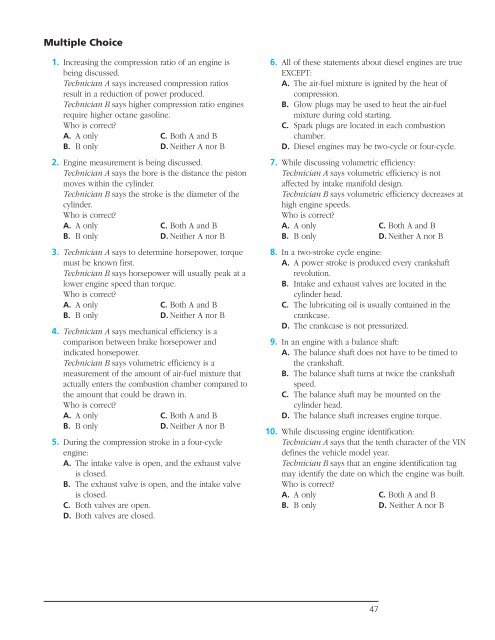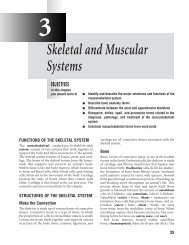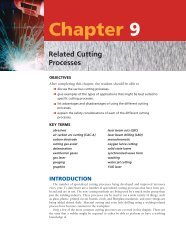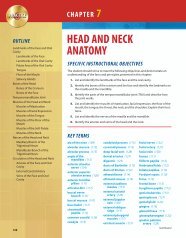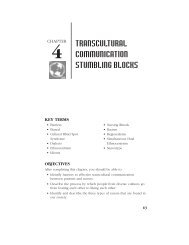Theory of Engine Operation - Delmar Learning
Theory of Engine Operation - Delmar Learning
Theory of Engine Operation - Delmar Learning
You also want an ePaper? Increase the reach of your titles
YUMPU automatically turns print PDFs into web optimized ePapers that Google loves.
Multiple Choice<br />
1. Increasing the compression ratio <strong>of</strong> an engine is<br />
being discussed.<br />
Technician A says increased compression ratios<br />
result in a reduction <strong>of</strong> power produced.<br />
Technician B says higher compression ratio engines<br />
require higher octane gasoline.<br />
Who is correct?<br />
A. A only C. Both A and B<br />
B. B only D. Neither A nor B<br />
2. <strong>Engine</strong> measurement is being discussed.<br />
Technician A says the bore is the distance the piston<br />
moves within the cylinder.<br />
Technician B says the stroke is the diameter <strong>of</strong> the<br />
cylinder.<br />
Who is correct?<br />
A. A only C. Both A and B<br />
B. B only D. Neither A nor B<br />
3. Technician A says to determine horsepower, torque<br />
must be known first.<br />
Technician B says horsepower will usually peak at a<br />
lower engine speed than torque.<br />
Who is correct?<br />
A. A only C. Both A and B<br />
B. B only D. Neither A nor B<br />
4. Technician A says mechanical efficiency is a<br />
comparison between brake horsepower and<br />
indicated horsepower.<br />
Technician B says volumetric efficiency is a<br />
measurement <strong>of</strong> the amount <strong>of</strong> air-fuel mixture that<br />
actually enters the combustion chamber compared to<br />
the amount that could be drawn in.<br />
Who is correct?<br />
A. A only C. Both A and B<br />
B. B only D. Neither A nor B<br />
5. During the compression stroke in a four-cycle<br />
engine:<br />
A. The intake valve is open, and the exhaust valve<br />
is closed.<br />
B. The exhaust valve is open, and the intake valve<br />
is closed.<br />
C. Both valves are open.<br />
D. Both valves are closed.<br />
6. All <strong>of</strong> these statements about diesel engines are true<br />
EXCEPT:<br />
A. The air-fuel mixture is ignited by the heat <strong>of</strong><br />
compression.<br />
B. Glow plugs may be used to heat the air-fuel<br />
mixture during cold starting.<br />
C. Spark plugs are located in each combustion<br />
chamber.<br />
D. Diesel engines may be two-cycle or four-cycle.<br />
7. While discussing volumetric efficiency:<br />
Technician A says volumetric efficiency is not<br />
affected by intake manifold design.<br />
Technician B says volumetric efficiency decreases at<br />
high engine speeds.<br />
Who is correct?<br />
A. A only C. Both A and B<br />
B. B only D. Neither A nor B<br />
8. In a two-stroke cycle engine:<br />
A. A power stroke is produced every crankshaft<br />
revolution.<br />
B. Intake and exhaust valves are located in the<br />
cylinder head.<br />
C. The lubricating oil is usually contained in the<br />
crankcase.<br />
D. The crankcase is not pressurized.<br />
9. In an engine with a balance shaft:<br />
A. The balance shaft does not have to be timed to<br />
the crankshaft.<br />
B. The balance shaft turns at twice the crankshaft<br />
speed.<br />
C. The balance shaft may be mounted on the<br />
cylinder head.<br />
D. The balance shaft increases engine torque.<br />
10. While discussing engine identification:<br />
Technician A says that the tenth character <strong>of</strong> the VIN<br />
defines the vehicle model year.<br />
Technician B says that an engine identification tag<br />
may identify the date on which the engine was built.<br />
Who is correct?<br />
A. A only C. Both A and B<br />
B. B only D. Neither A nor B<br />
47


